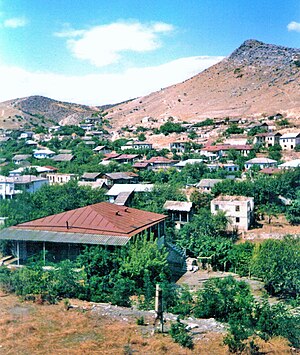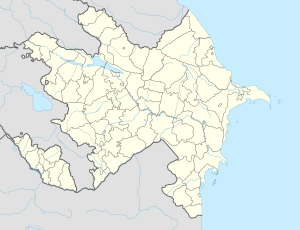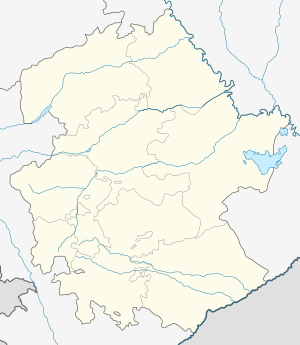Martakert (Armenian: Մարտակերտ, Russian: Мардакерт, also Mardakert, Մարդակերտ) or Aghdara (Azerbaijani: Ağdərə ⓘ) is a town in the Aghdara District of Azerbaijan,[2] in the region of Nagorno-Karabakh. Until 2023 it was controlled by the breakaway Republic of Artsakh, as the centre of its Martakert Province. The village had an ethnic Armenian-majority population[3] until the exodus of the Armenian population of Nagorno-Karabakh following the 2023 Azerbaijani offensive in Nagorno-Karabakh.[4] The town underwent heavy destruction by Azerbaijani forces while under their control during the First Nagorno-Karabakh War.[5]
Martakert / Aghdara
Մարտակերտ / Ağdərə | |
|---|---|
 Martakert in 2002 | |
| Coordinates: 40°12′55″N 46°48′46″E / 40.21528°N 46.81278°E | |
| Country | |
| • District | Aghdara |
| Elevation | 415 m (1,362 ft) |
| Population (2015)[1] | |
• Total | 4,600 |
| Time zone | UTC+4 (AZT) |
Etymology
Traditionally, the Armenian name of the town is interpreted as consisting of the elements mard ('man, person,' or in this context 'brave') and -kert ('built by'), supposedly referring to the inhabitants' reputation for bravery.[6] Other explanations link the name with the word matur’ ('chapel').[6] The Azerbaijani name for the settlement, Aghdara, translates to 'white river'.
History
The site of the settlement was historically a part of the Melikdom of Jraberd, one of the Melikdoms of Karabakh.[7]
In 1918, a battle took place near the town between Ottoman and Armenian forces where the latter emerged victorious.[6]
During the Soviet period, Martakert was the administrative centre of the Martakert District of the Nagorno-Karabakh Autonomous Oblast. It received the status of an urban-type settlement in 1960.
Nagorno-Karabakh conflict
First Nagorno-Karabakh War
During the First Nagorno-Karabakh War (1991–94), Martakert and the surrounding district saw heavy fighting, especially during the Azerbaijani Operation Goranboy and the Mardakert and Martuni Offensives in 1992.[7] The town was captured by Azerbaijani forces on 4 July 1992, forcing Martakert's Armenian population to flee the town.[8] Martakert was heavily damaged during the First Nagorno-Karabakh War and many of its buildings remain ruined and uninhabited.[8] According to Thomas Goltz, who was in Martakert in September 1992, the town became a "a pile of rubble", noting "more intimate detritus of destroyed private lives: pots and pans, suitcases leaking sullied clothes, crushed baby strollers and even family portraits, still in shattered frames".[9] HRW later noted that harsh actions taken by Karabakh Armenian forces during and after the offensive against Aghdam were seen as a revenge for the Azeri destruction of Martakert, in the context of the tit-for-tat nature of the conflict.[10] Martakert was recaptured by Armenian forces on 27 June 1993.[8] The area around the town has been controlled by Artsakh since the end of the war. Some of Martakert's natives gradually returned over the years, but many remained in Armenia, Russia, and elsewhere.[8]
Border clashes (1994–2020)
The 2008 Mardakert clashes began on 4 March after the 2008 Armenian election protests. It involved the heaviest fighting between ethnic Armenian[11] and Azerbaijani forces[12] over the disputed region of Nagorno-Karabakh[12][13] since the 1994 ceasefire after the First Nagorno-Karabakh War.
Armenian sources accused Azerbaijan of trying to take advantage of ongoing unrest in Armenia.[14] Azerbaijani sources blamed Armenia, claiming that the Armenian government was trying to divert attention from internal tensions in Armenia.[14]
In 2020, some clashes along the ceasefire lines took place near Martakert.
Second Nagorno-Karabakh war
During the Second Nagorno-Karabakh war, the town was bombed by Azerbaijani forces more than once, resulting in civilian deaths.[15][16]
2023 Nagorno-Karabakh offensive
The town came under Azerbaijani control on 24 September 2023, following the 2023 Nagorno-Karabakh offensive.[17]
Geography
The town is located on the right bank of the Tartar River, between two mountains.[6]
Economy and culture
The population mainly works in different state institutions as well as with agriculture. As of 2015, Martakert has a municipal building, a house of culture, two schools, two kindergartens, a youth centre, 88 commercial enterprises, two factories and a regional hospital.[18] The enlarged municipal community of Martakert includes the villages of Haykajur, Jraberd, Maralyan Sarov, and Levonarkh.[8]
Historical heritage sites
Historical heritage sites in and around the town include tombs from the 2nd–1st millennia BCE, the pre-Christian Kr’apasht Cemetery, the medieval village of T’aza Khach’, cemeteries from between the 17th and 19th centuries, St. John the Baptist Church (Surb Hovhannu Karapet Yekeghets’i) built in 1883 (possibly originating from as early as the 13th century), and a bridge across the Kusapat River from the early 20th century.[18][7]
Demographics
| Year | Armenians | Azerbaijanis | Russians | Ukrainians | Total | ||||
|---|---|---|---|---|---|---|---|---|---|
| 1907[6][19] | Mostly Armenian | 4,676 | |||||||
| 1970[20] | 5,472 | 96.3% | 135 | 2.4% | 44 | 0.8% | 9 | 0.2% | 5,683 |
| 1979[21] | 6,264 | 93.6% | 349 | 5.2% | 41 | 0.6% | 5 | 0.1% | 6,690 |
| 2005[22] | 4,262 | 100% | 4,262 | ||||||
| 2015[1] | 4,600 | 100% | 4,600 | ||||||
Climate
The climate in Martakert is classified as Humid subtropical climate (Cfa) by the Köppen climate classification.[23]
| Climate data for Mardakert, Nagorno-Karabakh Republic | |||||||||||||
|---|---|---|---|---|---|---|---|---|---|---|---|---|---|
| Month | Jan | Feb | Mar | Apr | May | Jun | Jul | Aug | Sep | Oct | Nov | Dec | Year |
| Mean daily maximum °C (°F) | 5.8 (42.4) |
6.6 (43.9) |
10.8 (51.4) |
18.3 (64.9) |
22.4 (72.3) |
27.0 (80.6) |
30.7 (87.3) |
29.2 (84.6) |
25.3 (77.5) |
18.4 (65.1) |
12.5 (54.5) |
8.1 (46.6) |
17.9 (64.3) |
| Mean daily minimum °C (°F) | −1.7 (28.9) |
−1.0 (30.2) |
2.3 (36.1) |
8.1 (46.6) |
12.5 (54.5) |
16.7 (62.1) |
20.0 (68.0) |
19.0 (66.2) |
15.4 (59.7) |
9.7 (49.5) |
4.8 (40.6) |
0.6 (33.1) |
8.9 (48.0) |
| Average precipitation mm (inches) | 15 (0.6) |
23 (0.9) |
34 (1.3) |
45 (1.8) |
71 (2.8) |
64 (2.5) |
31 (1.2) |
26 (1.0) |
27 (1.1) |
45 (1.8) |
28 (1.1) |
17 (0.7) |
426 (16.8) |
| Source: http://en.climate-data.org/location/21905/ | |||||||||||||
Twin towns – sister cities
- Vagarshapat, Armenia (2010–2023).[24]
Partnership agreement:
- Bourj Hammoud, Lebanon. In May 2018, representatives of the Artsakh city of Martakert and the Lebanese town of Bourj Hammoud signed a Memorandum of Cooperation. The memorandum states that aiming at the establishment of social, economic, tourism, and cultural relations between the two towns as well as realizing that cooperation between the towns can contribute to the strengthening of regional stability and peace.[25]
Gallery
-
Park and monument in Martakert
-
Martakert House of Culture
-
View from the town
-
One of the main streets in Martakert
-
Martakert Museum
-
Monument in Martakert
References
- ^ a b "Figures" (PDF). stat-nkr.am. 2015.
- ^ "Azərbaycan Respublikasının Ağdərə rayonunun yaradılması haqqında Azərbaycan Respublikasının Qanunu". President of Azerbaijan (in Azerbaijani). 27 December 2023. Archived from the original on 27 December 2023. Retrieved 28 December 2024.
- ^ Андрей Зубов. "Андрей Зубов. Карабах: Мир и Война". drugoivzgliad.com.
- ^ Sauer, Pjotr (2 October 2023). "'It's a ghost town': UN arrives in Nagorno-Karabakh to find ethnic Armenians have fled". The Guardian. ISSN 0261-3077. Retrieved 9 November 2023.
- ^ Azerbaijan: Seven Years of Conflict in Nagorno-Karabakh (PDF). Human Rights Watch/Helsinki. December 1, 1994. p. 35. Retrieved 3 June 2021.
- ^ a b c d e Hakobyan, Tadevos Kh.; Melik-Bakhshyan, Stepan T.; Barseghyan, Hovhannes Kh. (1986). Հայաստանի և հարակից շրջանների տեղանունների բառարան [Dictionary of toponymy of Armenia and adjacent territories] (in Armenian). Vol. 1. Yerevan: Yerevan State University Publishing House. p. 208.
- ^ a b c Kiesling, Brady; Kojian, Raffi (2019). Rediscovering Armenia: An in-depth inventory of villages and monuments in Armenia and Artsakh (3rd ed.). Armeniapedia Publishing.
- ^ a b c d e Hakobyan, Tatul (27 June 2021). "Մարտակերտի ազատագրումը. հունիս 27, 1993թ" [The liberation of Martakert, June 27, 1993]. ANI Armenian Research Center (in Armenian). Retrieved 29 June 2021.
- ^ Thomas Goltz. In TCG-33, Institute of Current World Affairs, Hanover, New Hampshire, September 18, 1992.
- ^ AZERBAIJAN: Seven Years of Conflict in Nagorno-Karabakh Human Rights Watch/Helsinki. page 47, 1994
- ^ "Karabakh casualty toll disputed". BBC News. 2008-03-05. Archived from the original on 9 March 2008. Retrieved 2008-03-05.
- ^ a b "Fatal Armenian-Azeri border clash". BBC News. 2008-03-05. Archived from the original on 5 March 2008. Retrieved 2008-03-05.
- ^ "Armenia/Azerbaijan: Deadly Fighting Erupts In Nagorno-Karabakh". Radio Free Europe/Radio Liberty. 2008-03-04. Archived from the original on 6 March 2008. Retrieved 2008-03-05.
- ^ a b "Deadly Fighting Erupts In Nagorno-Karabakh". RadioFreeEurope/RadioLiberty. 4 March 2008. Retrieved 2020-09-28.
- ^ ռ/կ, Ազատություն (30 September 2020). "Ադրբեջանի ռազմական ինքնաթիռը ռմբակոծել է Մարտակերտը, կա երեք զոհ. Վահրամ Պողոսյան". «Ազատ Եվրոպա/Ազատություն» ռադիոկայան (in Armenian). Retrieved 2021-06-29.
- ^ ռ/կ, Ազատություն (23 October 2020). "Մարտակերտը ռմբակոծվում է, կիրառվում է ռազմական ավիացիա, հայտնում է ԱԻՊԾ-ն". «Ազատ Եվրոպա/Ազատություն» ռադիոկայան (in Armenian). Retrieved 2021-06-29.
- ^ "Azerbaijani flag raised in Aghdara-VIDEO".
- ^ a b Hakob Ghahramanyan. "Directory of socio-economic characteristics of NKR administrative-territorial units (2015)".
- ^ Кавказский календарь на 1910 год [Caucasian calendar for 1910] (in Russian) (65th ed.). Tiflis: Tipografiya kantselyarii Ye.I.V. na Kavkaze, kazenny dom. 1910. p. 173. Archived from the original on 15 March 2022.
- ^ "Result of the Soviet census of 1970 of the Martakert district". www.ethno-kavkaz.narod.ru. Retrieved 2021-12-28.
- ^ "Result of the Soviet census of 1979 of the Martakert district". www.ethno-kavkaz.narod.ru. Retrieved 2021-12-28.
- ^ "The Results of the 2005 Census of the Nagorno-Karabakh Republic" (PDF). National Statistic Service of the Republic of Artsakh.
- ^ "Marakert / Agdere climate: Average Temperature, weather by month, Marakert / Agdere weather averages - Climate-Data.org". en.climate-data.org. Retrieved 2021-12-25.
- ^ Official page of Vagarshapat city
- ^ "Karabakh's Martakert, Lebanon's Bourj Hammoud sign memorandum of cooperation". news.am. Retrieved 2021-12-25.
External links
- World Gazetteer: Azerbaijan [dead link] – World-Gazetteer.com
- Martakert at GEOnet Names Server
- A short documentary about the town on YouTube

